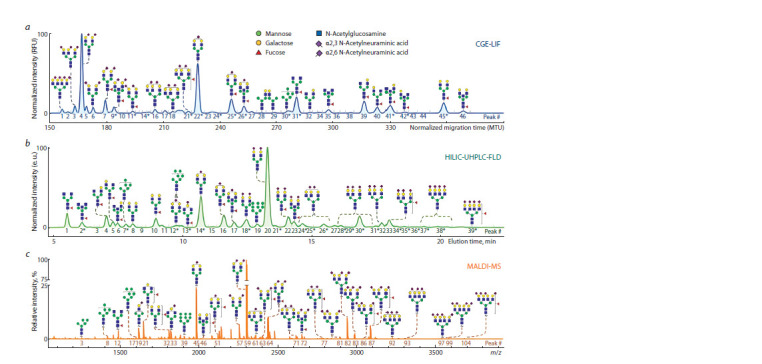人血浆蛋白n -糖基化的遗传控制。
IF 0.9
Q3 AGRICULTURE, MULTIDISCIPLINARY
引用次数: 0
摘要
糖基化是一种重要的蛋白质修饰,影响着蛋白质的物理化学性质和生物学功能。大规模人群研究表明,各种血浆蛋白n -聚糖的水平与许多多因素人类疾病有关。观察到的蛋白质糖基化水平与人类疾病之间的关联导致n -聚糖可以被认为是生物标志物和治疗靶点的潜在来源。尽管糖基化的生化途径已经得到了很好的研究,但对这些生化反应在体内的一般和组织特异性调节的机制的理解是有限的。这使得对观察到的蛋白质糖基化水平与人类疾病之间的关联的解释以及基于糖基的生物标志物和治疗方法的发展变得复杂。到2010年代初,高通量n -糖基化分析方法已经出现,允许使用定量遗传学方法研究n -糖基化的遗传控制,包括全基因组关联研究(GWAS)。这些方法的应用使得发现以前未知的n -糖基化调节因子成为可能,并扩大了对n -聚糖在控制多因子疾病和人类复杂性状中的作用的理解。本文综述了目前对人类血浆蛋白n -糖基化水平变异的遗传控制的了解。它简要地描述了最流行的n -聚糖分析的物理化学方法和数据库中包含的基因参与n -聚糖的生物合成。综述了影响n -聚糖变异的环境和遗传因素的研究结果,以及GWAS对n -聚糖基因组位点的定位结果。描述了功能性体外和计算机研究的结果。本文综述了糖基因组学的研究进展,并对今后的研究方向进行了展望。本文章由计算机程序翻译,如有差异,请以英文原文为准。



Genetic control of N-glycosylation of human blood plasma proteins.
Glycosylation is an important protein modification, which influences the physical and chemical properties as well as biological function of these proteins. Large-scale population studies have shown that the levels of various plasma protein N-glycans are associated with many multifactorial human diseases. Observed associations between protein glycosylation levels and human diseases have led to the conclusion that N-glycans can be considered a potential source of biomarkers and therapeutic targets. Although biochemical pathways of glycosylation are well studied, the understanding of the mechanisms underlying general and tissue-specific regulation of these biochemical reactions in vivo is limited. This complicates both the interpretation of the observed associations between protein glycosylation levels and human diseases, and the development of glycan-based biomarkers and therapeutics. By the beginning of the 2010s, high-throughput methods of N-glycome profiling had become available, allowing research into the genetic control of N-glycosylation using quantitative genetics methods, including genome-wide association studies (GWAS). Application of these methods has made it possible to find previously unknown regulators of N-glycosylation and expanded the understanding of the role of N-glycans in the control of multifactorial diseases and human complex traits. The present review considers the current knowledge of the genetic control of variability in the levels of N-glycosylation of plasma proteins in human populations. It briefly describes the most popular physical-chemical methods of N-glycome profiling and the databases that contain genes involved in the biosynthesis of N-glycans. It also reviews the results of studies of environmental and genetic factors contributing to the variability of N-glycans as well as the mapping results of the genomic loci of N-glycans by GWAS. The results of functional in vitro and in silico studies are described. The review summarizes the current progress in human glycogenomics and suggests possible directions for further research.
求助全文
通过发布文献求助,成功后即可免费获取论文全文。
去求助
来源期刊

Vavilovskii Zhurnal Genetiki i Selektsii
AGRICULTURE, MULTIDISCIPLINARY-
CiteScore
1.90
自引率
0.00%
发文量
119
审稿时长
8 weeks
期刊介绍:
The "Vavilov Journal of genetics and breeding" publishes original research and review articles in all key areas of modern plant, animal and human genetics, genomics, bioinformatics and biotechnology. One of the main objectives of the journal is integration of theoretical and applied research in the field of genetics. Special attention is paid to the most topical areas in modern genetics dealing with global concerns such as food security and human health.
 求助内容:
求助内容: 应助结果提醒方式:
应助结果提醒方式:


